
John Milton Cage Jr. was an American composer and music theorist. A pioneer of indeterminacy in music, electroacoustic music, and non-standard use of musical instruments, Cage was one of the leading figures of the post-war avant-garde. Critics have lauded him as one of the most influential composers of the 20th century. He was also instrumental in the development of modern dance, mostly through his association with choreographer Merce Cunningham, who was also Cage's romantic partner for most of their lives.

Charles Edward Ives was an American modernist composer, one of the first American composers of international renown. His music was largely ignored during his early career, and many of his works went unperformed for many years. Later in life, the quality of his music was publicly recognized through the efforts of contemporaries like Henry Cowell and Lou Harrison, and he came to be regarded as an "American original". He was also among the first composers to engage in a systematic program of experimental music, with musical techniques including polytonality, polyrhythm, tone clusters, aleatory elements, and quarter tones. His experimentation foreshadowed many musical innovations that were later more widely adopted during the 20th century. Hence, he is often regarded as the leading American composer of art music of the 20th century.
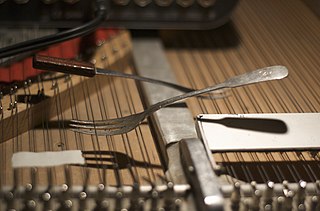
A prepared piano is a piano that has had its sounds temporarily altered by placing bolts, screws, mutes, rubber erasers, and/or other objects on or between the strings. Its invention is usually traced to John Cage's dance music for Bacchanale, created without room for a percussion orchestra. Cage has cited Henry Cowell as an inspiration for developing piano extended techniques, involving strings within a piano being manipulated instead of the keyboard. Typical of Cage's practice as summed up in the Sonatas and Interludes (1946–48) is that each key of the piano has its own characteristic timbre, and that the original pitch of the string will not necessarily be recognizable. Further variety is available with use of the una corda pedal.

Henry Dixon Cowell was an American composer, writer, pianist, publisher, teacher and the husband of Sidney Robertson Cowell. Earning a reputation as an extremely controversial performer and eccentric composer, Cowell became a leading figure of American avant-garde music for the first half of the 20th century — his writings and music serving as a great influence to similar artists at the time, including Lou Harrison, George Antheil, and John Cage, among others. He is considered one of America's most important and influential composers.

The Tides of Manaunaun is a short piano piece in B♭ minor by American composer Henry Cowell (1897–1965). It premiered publicly in 1917, serving as a prelude to a theatrical production, The Building of Banba. The Tides of Manaunaun is the best known of Cowell's many tone cluster pieces.
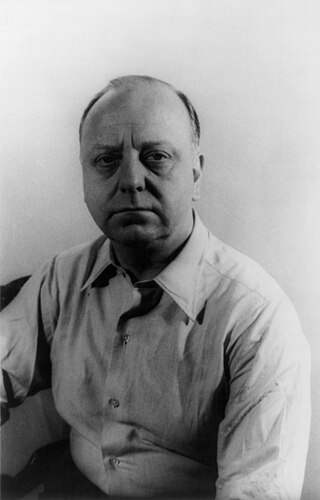
Virgil Thomson was an American composer and critic. He was instrumental in the development of the "American Sound" in classical music. He has been described as a modernist, a neoromantic, a neoclassicist, and a composer of "an Olympian blend of humanity and detachment" whose "expressive voice was always carefully muted" until his late opera Lord Byron which, in contrast to all his previous work, exhibited an emotional content that rises to "moments of real passion".

Henry Dreyfuss Brant was a Canadian-born American composer. An expert orchestrator with a flair for experimentation, many of Brant's works featured spatialization techniques.
A tone cluster is a musical chord comprising at least three adjacent tones in a scale. Prototypical tone clusters are based on the chromatic scale and are separated by semitones. For instance, three adjacent piano keys struck simultaneously produce a tone cluster. Variants of the tone cluster include chords comprising adjacent tones separated diatonically, pentatonically, or microtonally. On the piano, such clusters often involve the simultaneous striking of neighboring white or black keys.
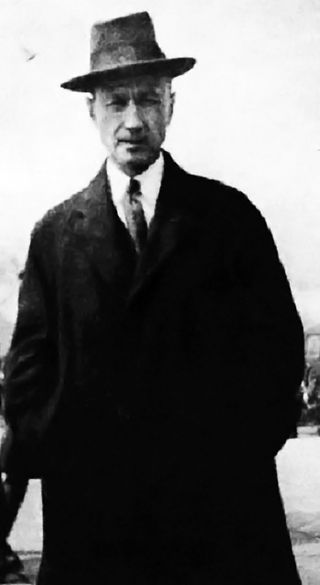
The Piano Sonata No. 2, Concord, Mass., 1840–60 is a piano sonata by Charles Ives. It is one of the composer's best-known and most highly regarded pieces. A typical performance of the piece lasts around 45 minutes.
Richard Lowe Teitelbaum was an American composer, keyboardist, and improvisor. A student of Allen Forte, Mel Powell, and Luigi Nono, he was known for his live electronic music and synthesizer performances. He was a pioneer of brain-wave music. He was also involved with world music and used Japanese, Indian, and western classical instruments and notation in both composition and improvisational settings.

Wallingford Constantine Riegger was an American modernist composer and pianist, best known for his orchestral and modern dance music. He was born in Albany, Georgia, but spent most of his career in New York City, helping elevate the status of other American composers such as Charles Ives and Henry Cowell. Riegger is noted for being one of the first American composers to use a form of serialism and the twelve-tone technique.
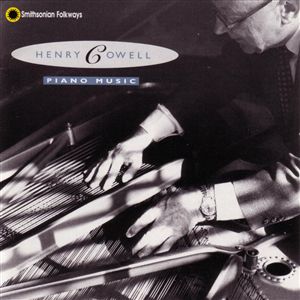
String piano is a term coined by American composer-theorist Henry Cowell (1897–1965) to collectively describe pianistic extended techniques in which sound is produced by direct manipulation of the strings, instead of or in addition to striking the piano's keys. Pioneered by Cowell in the 1920s, such techniques are now often called upon in the works of avant-garde classical music composers.

The Rhythmicon—also known as the Polyrhythmophone—was an electro-mechanical musical instrument designed and built by Leon Theremin for composer Henry Cowell, intended to reveal connections between rhythms, pitches and the harmonic series. It used a series of perforated spinning disks, similar to a Nipkow disk, to interrupt the flow of light between bulbs and phototoreceptors aligned with the disk perforations. The interrupted signals created oscillations which were perceived as rhythms or tones depending on the speed of the disks. Although it generated both pitches and rhythms, it has often been described as the world's first drum machine.
American avant-garde composer John Cage (1912–1992) began composing pieces for solo prepared piano around 1938–40. The majority of early works for this instrument were created to accompany dances by Cage's various collaborators, most frequently Merce Cunningham. In response to frequent criticisms of prepared piano, Cage cited numerous predecessors. In the liner notes for the very first recording of his most highly acclaimed work for prepared piano, Sonatas and Interludes, Cage wrote: "Composing for the prepared piano is not a criticism of the instrument. I'm only being practical." This article presents a complete list of Cage's works for prepared piano, with comments on each composition. All of Cage's indeterminate works for unspecified forces can also be performed on or with Prepared Piano.
Construction is the title of several pieces by American composer John Cage, all scored for unorthodox percussion instruments. The pieces were composed in 1939–42 while Cage was working at the Cornish School of the Arts in Seattle, Washington, and touring the West Coast with a percussion ensemble he and Lou Harrison had founded. The series comprises three Constructions. A piece titled Fourth Construction, mentioned in several sources, is apparently either an unfinished work from 1942 or, more likely, an early title of the work we now know as Imaginary Landscape No. 2 .
Johanna Magdalena Beyer was a German-American composer and pianist.

The Banshee (1925) is a piano composition by American composer Henry Cowell (1897–1965). It was the first piano piece ever written to be performed entirely free of the keyboard, using only manual manipulation of the strings within the instrument to produce sound via the flesh and nails of the finger.
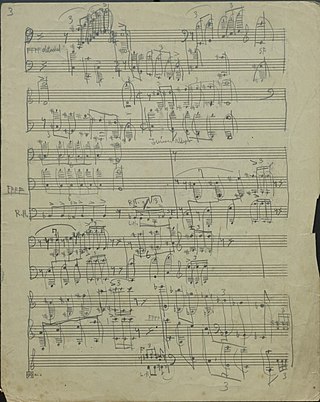
American composer Henry Cowell wrote one of his first surviving piano pieces, Dynamic Motion, in 1916. It is known as one of the first pieces in the history of music to utilize violent tone clusters for the keyboard. It requires the performer to use various limbs to play massive secundal chords, and calls for keys to be held down without sounding to extend its dissonant cluster overtones via sympathetic resonance. Some of the clusters outlined in this piece are those written for fists, palms, and forearms. The piece is also noted for its extended use of tuplets, featuring triplets, quintuplets, and sextuplets in the melody line.
Henry Cowell wrote the piano piece The Snows of Fuji-Yama, HC 395, in 1924.














